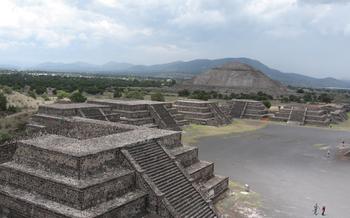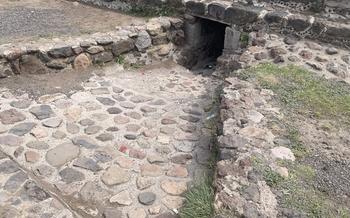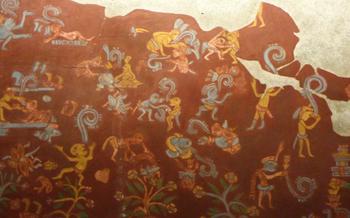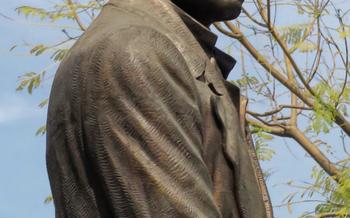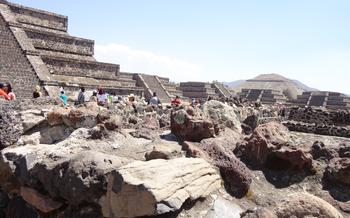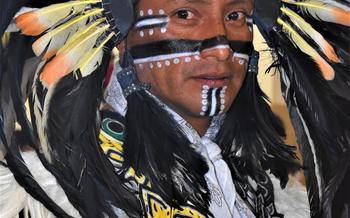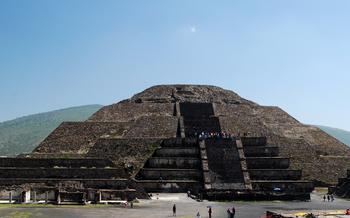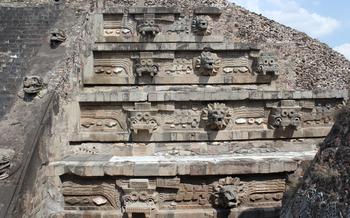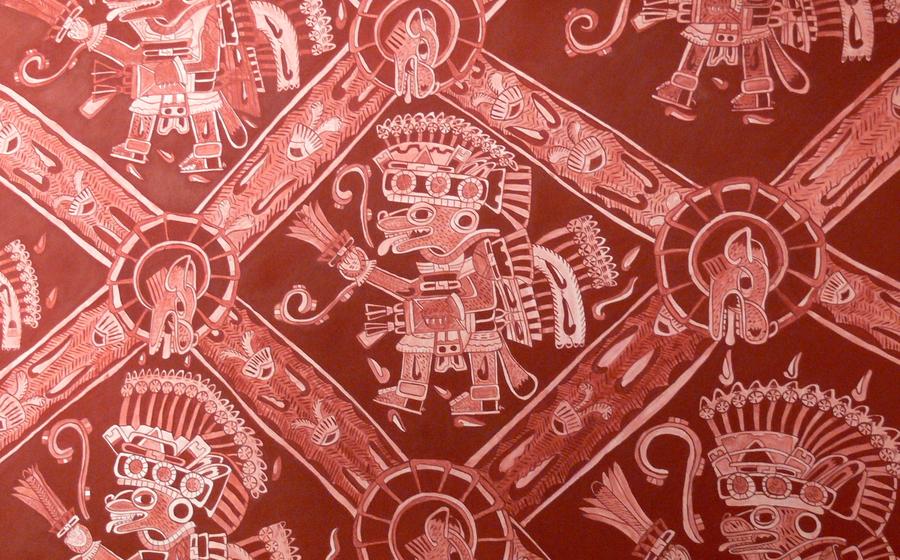
Palacio de Atetelco
- Excavating the Past: Unearthing the Palace's Secrets
- A Majestic Entrance: The Grand Staircase
- Throne Room: Seat of Authority
- Courtyards: Spaces for Gatherings and Ceremonies
- Residential Quarters: A Realm of Private Life
- Workshops and Storage Areas: Supporting the Palace's Needs
- Water Features: A Source of Life and Symbolism
- Visiting the Palacio de Atetelco: Practical Information
- Tips for Exploring the Palacio de Atetelco
- Insider Tip: Unveiling the Hidden Gem
Excavating the Past: Unearthing the Palace's Secrets
The discovery of the Palacio de Atetelco was a pivotal moment in the exploration of Teotihuacan's history. The initial excavations, conducted in the early 20th century, revealed the grandeur of the palace and provided valuable insights into the city's political and social organization. These early findings sparked a wave of interest and further research, leading to ongoing excavations and discoveries that continue to shed light on the palace's significance.
In recent years, advancements in archaeological techniques and methodologies have enabled researchers to delve deeper into the mysteries of the Palacio de Atetelco. Through careful excavations and analysis, they have uncovered new sections of the palace, revealing additional rooms, courtyards, and artifacts. These discoveries have provided a more comprehensive understanding of the palace's layout, functions, and the daily lives of its inhabitants.
However, the excavation process has also presented challenges and controversies. Interpreting the findings and piecing together the palace's history has been a complex task, requiring collaboration among archaeologists, historians, and other experts. Differing perspectives and interpretations have led to debates and discussions, contributing to the ongoing exploration and understanding of the Palacio de Atetelco.
A Majestic Entrance: The Grand Staircase
The Palacio de Atetelco boasts a grand staircase that serves as a majestic entrance to this ancient palace. Constructed with precision and skill, this architectural marvel showcases the advanced engineering prowess of the Teotihuacans. The staircase, meticulously crafted from stone, invites visitors to ascend and explore the palace's many wonders.
Beyond its practical function, the grand staircase holds deep symbolic significance. It represents the transition from the mundane world to the sacred realm of power and authority. As visitors climb the steps, they are symbolically elevated, leaving behind the ordinary to enter the extraordinary domain of the rulers.
The staircase also played a crucial role in connecting the palace to the Avenue of the Dead, the ceremonial boulevard that served as the heart of Teotihuacan. This strategic placement allowed the rulers to make grand entrances and processions, asserting their power and commanding the attention of the city's inhabitants.
Throne Room: Seat of Authority
In the heart of the Palacio de Atetelco, a majestic chamber awaits exploration—the Throne Room. This central chamber exudes an aura of power and grandeur, serving as the epicenter of decision-making and ceremonial gatherings. As you step into the Throne Room, the intricate murals and carvings transport you back in time, offering glimpses into the lives of the Teotihuacan rulers.
The throne itself, a symbol of authority and sovereignty, stands prominently in the room. Its elaborate adornments and intricate designs hint at the reverence and respect accorded to the rulers. Flanking the throne are altars, where offerings were made to the gods, seeking divine guidance and favor for the kingdom. The Throne Room served as a sacred space, where the earthly and spiritual realms converged, shaping the destiny of the Teotihuacan civilization.
Courtyards: Spaces for Gatherings and Ceremonies
The Palacio de Atetelco boasts multiple courtyards, each serving distinct social and ceremonial functions. The largest courtyard, known as the Great Courtyard, is a vast open space that could accommodate large gatherings and public ceremonies. Its central location and direct access to the Avenue of the Dead suggest its importance in hosting events of great significance.
Smaller courtyards, often connected to specific rooms or wings of the palace, served more intimate purposes. These courtyards provided private spaces for meetings, discussions, and smaller rituals. Their enclosed nature allowed for a greater degree of privacy and exclusivity, catering to the needs of the ruling elite and their close associates.
The architectural features of each courtyard vary, reflecting their specific functions and symbolic associations. Some courtyards feature elaborate decorations, such as murals, sculptures, and fountains, while others are more austere in design. These variations underscore the diverse roles that courtyards played in the daily life and rituals of the palace's inhabitants.
Residential Quarters: A Realm of Private Life
Within the confines of the Palacio de Atetelco, a private realm unfolds, revealing the living spaces of the elite who once called this palace home. These residential quarters, located in the palace's southern section, offer a glimpse into the daily lives and routines of Teotihuacan's ruling class.
The residential areas comprise a series of rooms arranged around courtyards, creating a sense of intimacy and seclusion. Each room served a specific purpose, from sleeping chambers and dining halls to storage spaces and private gardens. While the exact layout and dimensions of these rooms vary, they all share a common characteristic: an emphasis on privacy and comfort.
The walls of the residential quarters are adorned with vibrant murals and intricate carvings, depicting scenes from everyday life, religious ceremonies, and mythological tales. These artworks provide valuable insights into the beliefs, values, and aspirations of the palace's inhabitants.
Although much of the palace remains unexcavated, the residential quarters that have been uncovered offer a tantalizing glimpse into the private lives of Teotihuacan's elite. Here, visitors can imagine the daily routines, social interactions, and personal stories of the people who once walked these halls and courtyards.
Workshops and Storage Areas: Supporting the Palace's Needs
The Palacio de Atetelco was not merely a ceremonial and residential complex but also a hub of economic activity. Archaeological excavations have revealed the presence of workshops and storage areas within the palace grounds, providing insights into the diverse activities that supported the daily life of the palace inhabitants and the broader Teotihuacan community.
Evidence of craft production has been found in various workshops scattered throughout the palace. These workshops specialized in different crafts, such as pottery, obsidian working, and metallurgy. The discovery of tools, kilns, and unfinished products suggests that these workshops were actively involved in the production of goods for both domestic use and trade.
In addition to workshops, the palace also contained extensive storage facilities. These facilities, often located in underground chambers or hidden corners of the palace, were used to store a variety of goods, including food, water, and other resources necessary for the sustenance of the palace's large population. The efficient management of these resources was crucial for ensuring the smooth functioning of the palace and the well-being of its inhabitants.
The presence of workshops and storage areas within the Palacio de Atetelco highlights the palace's role as a center of economic activity. These facilities not only supported the daily needs of the palace community but also contributed to the economic prosperity of Teotihuacan as a whole.
Water Features: A Source of Life and Symbolism
The ancient Teotihuacans recognized the significance of water as a life-giving element, both practically and symbolically. The Palacio de Atetelco incorporated an elaborate water system, featuring canals and reservoirs that served various purposes. These channels not only provided a steady water supply for the palace inhabitants but also held deep cultural and religious meanings.
Water was considered sacred in Teotihuacan culture, associated with fertility, abundance, and the cycle of life and death. The presence of water features within the palace complex symbolized the divine presence and the palace's connection to the gods. The canals and reservoirs were carefully designed and aligned to create a harmonious flow of water, representing the balance and order of the universe.
Beyond their practical and symbolic functions, the water features of the Palacio de Atetelco also added to the aesthetic beauty of the palace. Ornamental fountains and decorative water elements adorned the courtyards, creating a serene and tranquil atmosphere. The sound of flowing water added a soothing ambiance to the palace, enhancing the overall sensory experience of its inhabitants.
Visiting the Palacio de Atetelco: Practical Information
Location and Access:
To reach the Palacio de Atetelco, make your way to the Teotihuacan Archaeological Zone, located approximately 50 kilometers northeast of Mexico City. Once inside the complex, follow the signs leading to the Ciudadela, a large enclosed plaza. The Palacio de Atetelco is situated on the eastern side of the Ciudadela, adjacent to the Avenue of the Dead.
Hours of Operation and Admission Fees:
The Palacio de Atetelco is open to the public daily from 9:00 AM to 5:00 PM. Admission fees are typically included in the general entrance ticket for the Teotihuacan Archaeological Zone, which costs around 85 Mexican pesos (approximately $50 USD) for foreign visitors.
Guided Tours:
Guided tours of the Palacio de Atetelco are available in various languages, including English and Spanish. These tours provide valuable insights into the history, architecture, and significance of the palace. Check with the ticket office or information center upon arrival for tour schedules and prices.
Tips for Exploring the Palacio de Atetelco
Comfortable Footwear: The uneven surfaces and staircases of the Palacio de Atetelco require sturdy and comfortable shoes. Choose footwear that provides good support and traction to ensure a safe and enjoyable exploration.
Sun Protection: The Mexican sun can be intense, especially during the midday hours. Protect yourself by wearing a hat, sunglasses, and sunscreen. Reapply sunscreen regularly to maintain effective protection.
Hydration: The warm climate of Teotihuacan can lead to dehydration. Carry a water bottle and stay hydrated throughout your visit to avoid discomfort. Drink water regularly, especially if you're exploring during the hotter parts of the day.
Insider Tip: Unveiling the Hidden Gem
While exploring the Palacio de Atetelco, don't limit yourself to the main complex. Venture beyond the well-trodden paths to discover hidden corners and lesser-known areas that offer unique insights into the palace's history and significance. Explore the surrounding courtyards, gardens, and workshops, each revealing a different aspect of life in this ancient city.
Engage with local guides to gain a deeper understanding of the palace and its context. They can share stories, legends, and historical facts that bring the site to life. Ask them to point out hidden details and symbols that you might have missed on your own. By exploring beyond the main complex and connecting with local experts, you'll uncover the true hidden gems of the Palacio de Atetelco, creating a richer and more meaningful experience.
